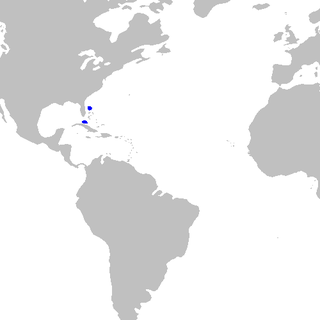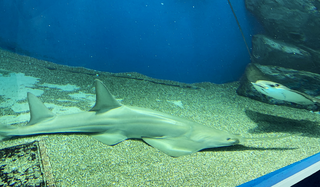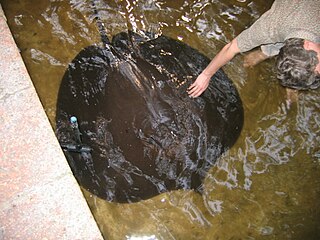
A sawshark or saw shark is a member of a shark order bearing a unique long, saw-like rostrum edged with sharp teeth, which they use to slash and disable their prey. There are eight species within the Pristiophoriformes, including the longnose or common sawshark, shortnose sawshark, Japanese sawshark, Bahamas sawshark, sixgill sawshark, African dwarf sawshark, Lana's sawshark and the tropical sawshark.

Sawfish, also known as carpenter sharks, are a family of rays characterized by a long, narrow, flattened rostrum, or nose extension, lined with sharp transverse teeth, arranged in a way that resembles a saw. They are among the largest fish with some species reaching lengths of about 7–7.6 m (23–25 ft). They are found worldwide in tropical and subtropical regions in coastal marine and brackish estuarine waters, as well as freshwater rivers and lakes. All species are endangered.

The Ganges shark is a critically endangered species of requiem shark found in the Ganges River and the Brahmaputra River of India and Bangladesh. It is often confused with the more common bull shark, which also inhabits the Ganges River and is sometimes incorrectly referred to as the Ganges shark. The genus is currently considered to contain three recent species; genetic evidence has shown that both the Borneo river shark and Irrawaddy river shark should be regarded as synonyms of the Ganges shark, expanding the range of the species to Pakistan, Myanmar, Borneo, and Java. While the other members of the genus Glyphis occur in coastal marine waters as well as rivers, the Ganges shark is found only in fresh water, making it the world's only exclusively freshwater shark. The species remains poorly known and very rare.

The Bahamas sawshark, Pristiophorus schroederi, is a sawshark of the family Pristiophoridae, found in the western Central Atlantic Ocean from the Bahamas and Cuba at depths of between 400 and 1,000 m. These sharks are at least 80 cm long.

The speartooth shark is a rare species of river shark, belonging to the family Carcharhinidae. It inhabits coastal marine waters and tidal reaches of large tropical rivers in northern Australia and New Guinea. Despite being a member of the river shark genus, it is also found in near-shore marine waters, favoring highly turbid environments over a wide range of salinities. This robustly built, gray-colored shark is characterized by a short and broad snout, tiny eyes, a relatively large second dorsal fin, and a black blotch beneath each pectoral fin near the tip. Another identifying trait is its teeth, which are large, triangular, and serrated in the upper jaw and narrow, spear-like, and serrated only near the tips in the lower jaw. Adults grow to about 2.6 m (8.5 ft) long.

The Australian blacktip shark is a species of requiem shark, in the family Carcharhinidae, endemic to northern and eastern Australia. Favoring the upper and middle parts of the water column, it can be found from the intertidal zone to a depth of 50 m (160 ft). Appearance-wise this species is virtually identical to the common blacktip shark, from which it can be reliably distinguished only by its lower vertebra number and by genetic markers. Generally reaching 1.5–1.8 m (4.9–5.9 ft) in length, it is a fairly stout-bodied, bronze-colored shark with a long snout and black-tipped fins.
The narrow sawfish, also known as the pointed sawfish or knifetooth sawfish, is a species of sawfish in the family Pristidae, part of the Batoidea, a superorder of cartilaginous fish that include the rays and skates. Sawfish display a circumglobal distribution in warm marine and freshwater habitats. Their extant biodiversity is limited to five species belonging to two genera. The sawfishes are characterised by the long, narrow, flattened rostrum or extension on their snout. This is lined with sharp transverse teeth, arranged in a way that resembles the teeth of a saw and are used for killing prey. It is found in the shallow coastal waters and estuaries of the Indo-West Pacific, ranging from the Persian Gulf to southern Japan, Papua New Guinea and northern Australia. It is the only living member of the genus Anoxypristis, but was previously included in the genus Pristis. Compared to Pristis, Anoxypristis has a narrower rostral saw with numerous teeth on the distal part and no teeth on the basal one-quarter. It reaches a length of up to 3.5 m (11 ft).

The dwarf sawfish or Queensland sawfish, Pristis clavata, is a sawfish of the family Pristidae, found in tropical Australia. This endangered species is the smallest species in its family.

The smalltooth sawfish is a species of sawfish in the family Pristidae. It is found in shallow tropical and subtropical waters in coastal and estuarine parts of the Atlantic. Reports from elsewhere are now believed to be misidentifications of other species of sawfish. It is a critically endangered species that has disappeared from much of its historical range.

The longcomb sawfish, narrowsnout sawfish or green sawfish is a species of sawfish in the family Pristidae, found in tropical and subtropical waters of the Indo-West Pacific. It has declined drastically and is now considered a critically endangered species.

The humpback smooth-hound is a species of houndshark and a part of the family Triakidae.The most noticeable difference between Mustelus whitneyi and its relatives, is the slight curvature, causing a "humpback" appearance located in front of its primary dorsal fin. It is found on the continental shelves of the tropical southeast Pacific, from Peru to southern Chile, between latitudes 3° S and 54° S. These sharks are demersal feeders but range from depths between 15 and 210 metres. Humpback smooth-hound sharks are small sharks, reaching a maximum size of 118cm in total length. Mustelus whitneyi typically feed on teleosts and invertebrates in the benthic and pelagic ecosystems, most important prey being the peruvian anchovy. These humpback smooth-hound sharks are placental viviparious sharks, meaning that the embryo forms inside the mother tethered by the placental cord. The threats currently causing population decline to humpback smooth-hound sharks surround issues with local fisheries and management.

The giant freshwater stingray is a species of stingray in the family Dasyatidae. It is found in large rivers and estuaries in Southeast Asia and Borneo, though historically it may have been more widely distributed in South and Southeast Asia. The largest freshwater fish and the largest stingray in the world, this species grows up to 2.2 m (7.2 ft) across and can reach up to 300 kg (660 lb) in weight. It has a relatively thin, oval pectoral fin disc that is widest anteriorly, and a sharply pointed snout with a protruding tip. Its tail is thin and whip-like, and lacks fin folds. This species is uniformly grayish brown above and white below; the underside of the pectoral and pelvic fins bear distinctive wide, dark bands on their posterior margins.

Rhina ancylostoma, the bowmouth guitarfish, shark ray or mud skate, is a species of ray and a member of the family Rhinidae. Its evolutionary affinities are not fully resolved, though it may be related to true guitarfishes and skates. This rare species occurs widely in the tropical coastal waters of the western Indo-Pacific, at depths of up to 90 m (300 ft). Highly distinctive in appearance, Rhina ancylostoma has a wide and thick body with a rounded snout and large shark-like dorsal and tail fins. Its mouth forms a W-shaped undulating line, and there are multiple thorny ridges over its head and back. It has a dorsal color pattern of many white spots over a bluish gray to brown background, with a pair of prominent black markings over the pectoral fins. This large species can reach a length of 2.7 m (8.9 ft) and weight of 135 kg (298 lb).

Pristis is a genus of sawfish of the family Pristidae. These large fish are found worldwide in tropical and subtropical regions in coastal marine waters, estuaries, and freshwater lakes and rivers. Sawfish have declined drastically and all species are considered critically endangered today.

Batoidea is a superorder of cartilaginous fishes, commonly known as rays. They and their close relatives, the sharks, comprise the subclass Elasmobranchii. Rays are the largest group of cartilaginous fishes, with well over 600 species in 26 families. Rays are distinguished by their flattened bodies, enlarged pectoral fins that are fused to the head, and gill slits that are placed on their ventral surfaces.

Nicholas Kevin Dulvy is a Distinguished Professor and Canada Research Chair in Marine Biodiversity and Conservation at Simon Fraser University. He was the Co-Chair of the International Union for Conservation of Nature (IUCN) Shark Specialist Group from 2009–2020. He has published more than 100 peer-reviewed papers and book chapters on life histories, extinction risk, the ecosystem impacts of fishing and the ecological and socioeconomic impacts of climate change.
The Robinson River is a river in Australia's Northern Territory.

Atlanticopristis is an extinct genus of sclerorhynchid that lived during the Middle Cretaceous (Cenomanian) of what is now the Northeast Region of Brazil, between 100.5 and 93.9 million years ago. Fourteen fossil teeth from Atlanticopristis were found in the Alcântara Formation, and referred to the closely related Onchopristis in 2007; a redescription in 2008 by Brazilian paleontologists Manuel Medeiros and Agostinha Pereira assigned it to a new genus containing one species, Atlanticopristis equatorialis.





















